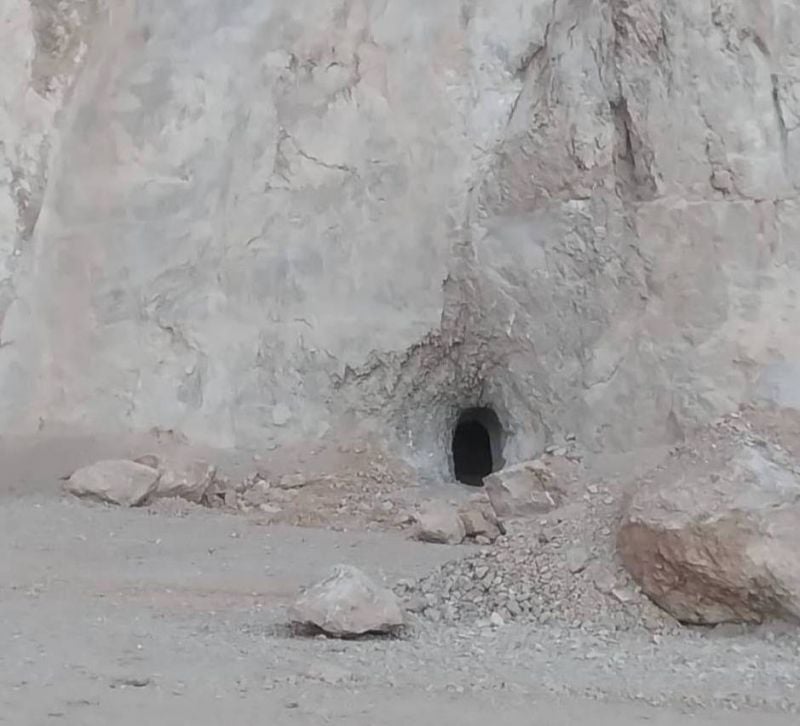
A photo circulating on social media of the wall where explosions took place on Saturday followed by an earthquake in Zahle, Bekaa. (Credit: Twitter: @AbdlhKamh)
BEIRUT — Tony Nemer, professor of geology and seismology at the American University of Beirut, told L'Orient Today on Sunday that rock blasting in the Bekaa Valley town of Zahle on Saturday "most probably" induced an earthquake measuring 3.0 on the Richter scale.
Nemr's claim that human activity was behind the quake was refuted on Monday by Lebanon's National Scientific Research Council (CNRS), which estimates a "99 percent" chance that the tremor was natural in origin.
Zahle and Bekaa residents on Saturday reported hearing a loud blast, seeing smoke and feeling a strong tremor, according to Nemr and L'Orient Today's correspondent in the region.
A rock blasting was carried out on Saturday in the Twity quarry in Qa’a al-Rim area, Zahle, using large quantities of nitrate explosives, according to our correspondent.
The blast was followed by a quake measuring 3.0 on the Richter scale, according to Nemr, who quoted the National Center for Geophysics in Bhannes.
Nemr confirmed that using explosives on the Earth's surface could trigger earthquakes, namely "when these explosions take place in certain areas close to fault lines."
The explosions could "alter the stresses on the faults causing earthquakes," leading to "human-induced seismicity."
However, he explained that in order to confirm that the earthquake that took place yesterday in Zahle "was caused by the explosives instead of natural triggers, I need to obtain the seismogram from [National Center for Geophysics in Bhannes] but unfortunately [the National Center for Geophysics in Bhannes] does not normally give out such information, for internal reasons that I cannot speculate."
Yammouneh fault
For perspective, Nemr gave the example of two earthquakes that followed explosions in a quarry in Kesrouan, northeast Lebanon, on May 6.
"The explosions were followed by an earthquake, and after one hour, another earthquake took place that had the depth of nine kilometers," Nemr told L'Orient Today. "Most probably, the second earthquake was triggered by the first earthquake, which the explosives caused."
"The earthquake on the outskirts of Zahle is suspicious, similar to the earthquake of May 6 on the outskirts of Kesrouan, in terms of timing (Saturday afternoon) and location (quarry area)," Nemr said on Twitter. "The security forces should take the matter seriously to verify the causes of these tremors and stop them if they were caused by explosions, because such actions may trigger earthquakes with unimaginable consequences."
Commenting on a picture of the reported rock blasting site posted by another Twitter user, Nemr added that "the wall in the photo is a natural wall of rock and is a visible part of a large fault in the area, most likely the Yammouneh fault."
The Yammouneh fault line is a 220-kilometer-long stretch of the Levant fault line, which extends from south Turkey to the Red Sea, passing through Lebanon.
Quarry closed with red wax
Meanwhile, Bekaa Governor Kamal Abu Jaoudeh referred the case of the explosion that possibly caused an earthquake to the Sub-Security Council, and investigations were launched under the supervision of the military public prosecution as well as the appeals public prosecutor in the Bekaa, Munif Barakat, according to our correspondent.
Earlier on Saturday, caretaker Environment Minister Nasser Yassin said that his ministry had issued a decision to close with red wax the quarry in which the blast was heard "some time ago."
Additional reporting by Sarah Abdallah